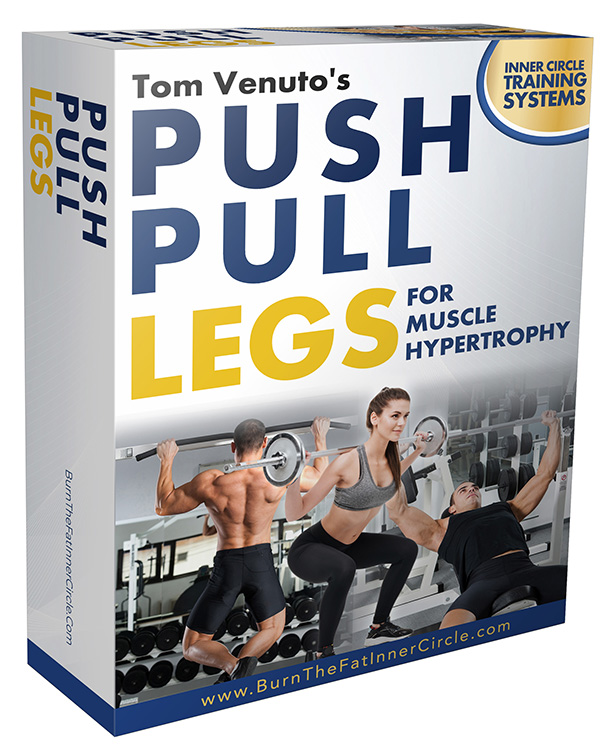Despite what some training gurus might lead you to believe, there’s no single best split routine for building muscle. You can build a lot of muscle with a variety of different training splits. In fact, it’s possible to build a lot of muscle with no split routine at all. Full body workouts have their place, especially for beginners, for time efficiency and for “back to basics” strength training. But suppose you have a bodybuilding (visual aesthetics) goal. Is a split routine always the best? Is it better than full body training? What are the pros and cons of each? What are the best split routine options? And how do you choose one? All the answers are in today’s question and answer column below…

Q: Tom, I see that you now have full body, 2 day, 3 day, 4 day, and 5 day splits on your Inner Circle site. Do you think a body part split will give greater muscle gains in a shorter time than a full body or upper-lower program? If so, what do you think is the best split routine for building muscle? For example, I’m especially interested in the 3-day options like Day 1: Chest/Shoulders/Triceps, Day 2: Back/Biceps/Forearms, Day 3:Legs/Abs. But I’m also wondering about breaking it up to a 4 or 5 day split where you basically do one major body part per workout. What’s more beneficial to someone who wants to add the most muscle and keep bodyfat levels low, in the least time possible?
A: The short answer is you’ll probably get similar muscle gains from either a 3 day (push pull legs) split or a 4 day or a 5 day split (aka one body part a day, aka “bro” split). Your gains will also be similar to what you might get with a 2-day split or a full body routine as well, but under one condition: The weekly volume (number of hard sets per muscle per week) is the same.
On the other hand, if one of those routines allows you to easily accumulate more weekly sets than the other, then that routine might give you an advantage for muscle gains. This is one of the reasons that almost all bodybuilders use body part splits, not full body routines. Body part splits are usually the best choice for physique athletes.
The 3-day push pull legs split is the most traditional schedule and when you have muscle size goals, it’s hard to go wrong with that choice. It typically involves 5 days a week of lifting (sometimes 6 for advanced competitive bodybuilders).
The 5-day split is more unconventional, and some say controversial, because if you train 5 days a week (like Mon to Fri with weekends off), each muscle is trained with a much lower weekly frequency. However, it’s a popular routine and many people do it for the increased recovery between workouts or they choose this split purely out of enjoyment.
You could probably get similar muscle gains with a 4-day split as well. And, you could do a 3-day push-pull-legs split with only 4 workouts a week, which would help people who need more recovery.
The number of days per week you’re willing and able to train is one of the factors involved when deciding what routine to choose. The decision should also be based on your goals, training age, personal preferences, and your recovery ability. Let me explain in a little more detail.
Pros And Cons Of Body Part Split Routines… And How To Choose The Right One For You.
For a while, body part split routines lost some popularity in the mainstream fitness community. These routines, especially the ones where you only work one major muscle per session, were even criticized by personal trainers and sports conditioning coaches. Sometimes that’s justifiable given the context of sports training and general population fitness, where split routines were deemed “non-functional.”
Despite the “flavor of the day” phenomenon in the fitness and diet industry, where new and different trends come and go, body part split routines actually never went anywhere. Competitive bodybuilders use them as their standard training method and always have. That’s because body part splits are extremely effective for muscle growth (hypertrophy) and visual / cosmetic physique goals.
Bodybuilders are the most muscular athletes in the world, who also happen to carry the lowest body fat of all athletes at contest time. If that’s what you’re looking for – a program to add muscle size in all the right places (visual aesthetics) – then split routines are a terrific option. 3, 4 and 5 day splits can all be effective.
How to set up split routines is a big subject that could fill a chunk of an entire weight training book, but let me give you a quick overview of some of the best schedules.
There are 4 very popular split options among bodybuilders. For achieving bodybuilding goals, my favorites are the 3-day and 4-day splits, but yes we did recently add a 5-day split (aka “bro split”) to the Inner Circle training department recently and some people really enjoy it.
Also, the 2-day split is still used by some bodybuilders and is probably the most popular schedule for the recreational lifter. For the advanced bodybuilder the 3-day split, especially the push-pull-legs split is most popular.
The 2 day Split, upper, lower + abs aka “The New Body” (“TNB”) split
Day 1: Upper body
Day 2: Lower body and abs
The 3 day Split, antagonistic (aka “classic muscle”)
Day 1: Chest, back
Day 2: Shoulders, Biceps, Triceps
Day 3: Quads, Hams
The 3 day Split, push-pull-legs
Day 1: Chest, shoulders, triceps
Day 2: Back, biceps, forearms
Day 3: Quads, hams, calves
The 4 day Split
Day 1: Chest, biceps, abs
Day 2: Quads, hams
Day 3: Shoulders, Triceps
Day 4: Back, calves
*Note: There are many body part grouping variations on this split
The 5 day Split (aka “bro split”)
Day 1: Chest, abs
Day 2: Back, calves
Day 3: Shoulders
Day 4: Arms
Day 5: Legs (quads and hams)
* Possible weekly schedule arrangements for these splits are endless, but a common way to do the 3 or 4 day split is 3 on 1 off or 4 on 1 off then repeat the cycle (rotating schedule). Alternately 5 days a week are designated for training and 2 days off for recovery (fixed schedule).
It’s important to note that 3, 4 and 5 day body part splits are definitely bodybuilding-focused routines. I’m referring to bodybuilding literally, as in the competitor or recreational lifters who have visual / aesthetic goals.
All of your training decisions should be made within the context of your goals, time availability, experience level, and personal preferences. Depending on your goals, there are advantages or disadvantages to body part split routines. Certain individuals might want to stick with full body workouts or the more basic 2 day (upper / lower + abs) split.
Advantages of body part splits:
1. Energy allocation.
If you only have to train one body major part in a session, you can put 100% physical energy into that muscle. If you have to train all your major muscle groups in one session, that is energy-draining. Whatever is done last in the workout will always suffer compared to what is done first. This is a particularly important consideration for “priority training” when one body part is lagging in comparison to others.
2. Mental concentration.
Many bodybuilders say that beyond physical energy allocation, they can mentally focus better with only one or two body parts to train per session. The mind to muscle connection is extremely important in physique training.
3. Time to do more volume.
The beginner doesn’t need a lot of training volume. The advanced bodybuilder on the other hand, can not only handle more volume, but also often finds they need more sets and exercises to maximize their gains. If you’re training your full body or even half your body per session, you can only do so much volume without the workouts dragging on a long time. To train with the desired amount of volume and keep the workouts a reasonable duration, this requires split routines. It’s also worth noting that if a certain split routine allows someone to achieve more weekly volume than another routine, this could produce greater muscle gains.
4. Time to do more exercises/angles.
Split routines not only allow you to do more volume in terms of number of sets, you can also do multiple exercises for each muscle. A football player doesn’t care about rear deltoid development or whether the lateral deltoid has enough width and “cap.” A bodybuilder on the other hand, wants to develop a muscle from every angle for aesthetics. On shoulder day for example, that would include front, side and rear deltoid exercises, plus trapezius. On a mass/ strength program that only works the basic compound exercises, one might only do a military press. That can produce a good amount of size, but does not work every aspect of the muscle and does not allow the bodybuilder to specialize on one part of a muscle that might be lagging (example: rear delt exercise), in order to develop symmetry.
Disadvantages of body part splits:
1. Body part split routines are usually not appropriate for all athletes.
Athletic training usually focuses on movement patterns not individual muscles. For example: horizontal push, vertical pull, rotation, etc. It may also involve plyometric or power training. Strength athletes usually focus on lifts, not individual muscles. For example: bench day, squat day and deadlift day, with assistance work done after the main lifts.
2. Body part split routines are usually not appropriate for beginners.
A rank beginner usually does best with a full body routine and a small number of basic exercises. An intermediate or recreational bodybuilder could choose any type of training schedule, but can’t go wrong with a 2 day split (such as our T.N.B. program). The body part splits are best for bodybuilders or advanced trainees with hypertrophy goals and cosmetic/ visual goals. So consider your training age a when making a decision on your lifting schedule.
3. Body part splits may not be practical for some people’s lifestyle and schedule.
Many people don’t want to train 5 (or 6) days a week because that is a big commitment. A 4 day schedule is most common for experienced recreational lifters. On a program like our T.N.B., which is a 2 day upper – lower schedule (or a typical strength program), you can get excellent muscle development with a 4 days per week frequency. When someone only wants to lift 3 days a week, a full body routine is a good choice.
4 Major Factors in choosing your lifting schedule
As you can see, there are many considerations which might influence your choice of training schedule and split routine. To conclude, let’s review the big 5:
1. Goals (strength or sports or bodybuilding/aesthetics)
2. Training age (beginner or advanced)
3. Time available / schedule considerations
4. Personal preference
5. Your results
It doesn’t hurt to try a wide variety of training schedules. You might find one in particular that you stick to most of the time as your default program because it works well and you enjoy it. Or you might find that the novelty effect of rotating different training schedules and frequencies throughout the year helps stimulate greater muscle gains than doing the same program year round.
Again, I don’t think it’s possible to say there is a best split routine for building muscle. However, if you weigh all the pros and cons and consider these factors above, then one particular type of schedule might leap out at you as the most logical choice given your personal goals and your lifestyle.
While there might not be a best one, I can easily say that for experienced trainees who want to build muscle size, the most popular one has got to be the 3-day push-pull-legs split. This is a classic, proven program that has been round for years. In 2024 an all-new version of this classic was released in our Burn the Fat Inner Circle training department. You can learn more about it and why it’s so popular here:
==>Tom Venuto’s New PUSH-PULL-LEGS 2024
Tom Venuto,
Founder and CEO, Burn the Fat Inner Circle







Thanks for this the two day split looks interesting. Do you repeat each workout twice a week? Also could you comment on sets and reps? 3x 10, 4×8, 2×20 etc. What’s good for burning fat, what’s good for building muscle and beginner to advanced.
Thanks so much
Sarah
Sarah on a 2 day split, yes, the frequency of working each body part or exercise is usually twice a week shown above. When moving on to 3, 4 and 5 day splits (bodybuilding style workouts) the frequency of working each muscle group can vary anywhere from once every 4 days to once every 7 days. Whats good for burning fat is nailing the nutrition and adding some cardio. one does not necessarily have to alter the weight training style. Many weight training programs are designed to create the most fat loss or be most compatible with fat loss goals, but with bodybuilding style split weight training routines, the weight lifting is done for strength and muscle growth and fat loss benefit is secondary – the bodybuilder is using diet + cardio to get lean.
I like the four day TNB and four day split, but can I alternate rest days between cardio and weights. E.g. M, W, F, Sat, Weights. Cardio on off days.
Is this possible without losing muscle or strength in the process?
absolutely. Arguably, thats even ideal. until/ unless you want to do more than 3 days a week of cardio, then it inevitable that on some days you’ll do weights and cardio in the same day… which is fine, but to avoid losing strength/ muscle id suggest doing cardio after weights not before – cardio before weights, if its intense, will interfere with weight lifting performance and thats not a compromise you want to make if strength and muscle are high on your priority list
I always thought the rest factor was part of the advantage of splitting off parts for individual workouts.
You work one part to exhaustion, then give it a few days to rebuild and recooperate…no?
absolutely phil. Although many people – especially beginners – can train 3 days a week on a full body workout (no split) with only one rest day in between and fully recuperate from that. On the other end of the spectrum you have advanced bodybuilers who prefer working on only one or two body parts in a session and they do a lot of exercises, a lot of sets, a lot of volume and that causes a lot more muscle damage compared to the lower volume workout youd be doing on a full body program, and in that case the extended time between workouts is indeed part of the advantage.
Great article! It really explained how to decide what kind of a routine is appropriate for one’s goals. Thanks for your clarity!!
Love the comments, absolutely all true as we well know! First time I ever looked at your web-site. Very impressive! I’ve been telling people very similar things for years when asked at the gym about how to train and eat. Of course, I do not have near the knowledge or training experience as you. But have learned the basic common sense principles you speak of through my 37 years of training. In fact, without ever visiting your site, I constantly refer people to it by your name- knowing they will get sound no bullshit advice/ knowledge from a guy with integrity who has done it the right way- Naturally!! When I think back over over the years of training and folks I’ve known, there’s really only two I think of that keep it clean and natural and are still training because of it- You and John Venditti. That’s not many considering all the lifters I’ve known in my time. Keep up the good work! It would be good to hear from ya.
Hi Tom. I wanted to know if I can at some point in time eventually reach my genetic potential using minimalist routines doing at least two sets per exercise two workout sessions per week?
Its doubtful that one would make gains and continue gaining up to genetic potential on minimalist routines. Thats because there’s so. much evidence today that muscle growth is related to training volume. That’s to say, more is better, up to a certain point. However, I do believe you can maintain muscle you’ve already built on a surprisingly minimal amount of volume
Hi Tom. I’m a big fan and used info from your blogs and books when I competed and it helped a ton. I personally use the four day split you use. It is ideal for me but I keep coming across articles where they say a training frequency of training a muscle group twice a week is best for muscle growth. I have tried hitting an upper lower routine but find it to be very draining. Out of your experience do you find training a muscle group once every 7 days just as effective as every 3rd or 4th day.I do 9 sets total for the big body part and 4 to 6 total sets for a small body part for example in a workout. I appreciate your knowledge ando articles.
Thanks!
Ive seen the trend toward the recommendation of higher training frequency and I understand the reasons why h ave a lot to do with recent research about protein synthesis rates. Trying a higher training frequency may indeed help in some situations. However, i have zero reason to beleive that traditional bodybuilding routines that work each muscle once every 5 to 7 days arent also effective. To compare this type of training vs more frequent training one has to keep in mind that the volume of work may be different, as may the intensity. and that both methods could work. The majority of bodybuilders I know still train with a frequency of once every 5 to 7 days and do more volume. The weekly volume might be similar but if you switch to twice a week, you often have to decrease the volume per workout or you’ll be in the gym for hours. Each method has its pros and cons. I lean a bit more toward prescribing twice a week for the regular recreational lifter. However, Im not jumping on this bandwagon anymore than i have any of the others that have come down the pike over the years. Im still much more in favor of body part split routines and once every 5 to 6 days frequencies myself for serious bodybuilding goals for all the reasons discussed in the article, and others…. including the fact that it works better than anything else ive ever tried. That said, I sometimes train small muscle groups or lagging muscle groups more often while doing a bodybuilding split routine. This is called variable split training, where each muscle is not worked with the same frequency. If what you are doing is working, keep doing it. If you have a lagging muscle, try hitting it more often, at least for a short period of time and see what happens.
Tom. I have the original BFFM PDF book and the New BFFM TNB book. I like the leg workout in the TBN exercises, but feel my muscle gains in biceps, etc. suffer using TNB. Question: Can I do a 4 day split using the exercises for the various muscle groups listen int the TNB workouts? E.g. Chest, Biceps, Abs. 3 chest exercises, 3 Biceps exercises, and then 2 or 3 ab exercises from the table of exercises in the TNB workouts.
You could do a 3 day split or a 4 day split and this allows you time to add a lot more volume for direct arm work. I use a 4 day split myself; 1: shoulders triceps, 2: back, calves, 3: chest, biceps, abs, 4: quads, hams
Its strange i always was getting smaller with a high frequency routine even in a calorie surplus. Think my body responds better with a high volume low frequency approach.
Individual response can vary a lot. I know a lot of people who do better with more volume per workout and lower frequency, even though the “science-based” training community today really pushes on 2X per week frequency and spreading volume across week more. Im like you. I much prefer working each muscle once every 5 days or so with more volume per workout and no one (or study) will change mind. It pays to follow the science but also pays to pay attention to our own results and keep doing more of whats working. Cheers.